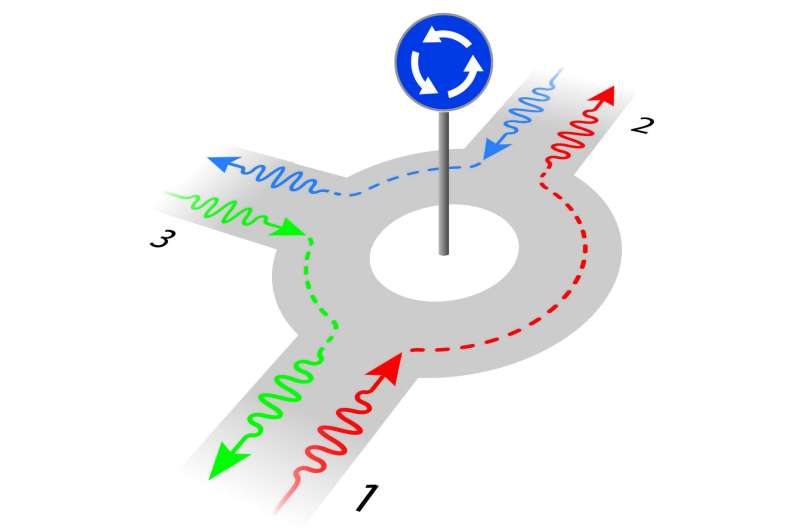Essential quantum computer component downsized by two orders of magnitude

Qubits, or quantum bits, are the key building blocks at the heart of every quantum computer. In order to perform a computation, signals are directed to and from qubits. However, qubits are extremely sensitive to interference from their environment, and need to be shielded from outside signals, in particular from magnetic fields. It is a serious problem that the devices built to shield qubits from unwanted signals, known as nonreciprocal devices, produce magnetic fields themselves. Moreover, they are several centimeters in size, which is problematic, given that a large number of such elements is required in each quantum processor.
Now, scientists at the Institute of Science and Technology Austria (IST Austria), simultaneously with competing groups in Switzerland and the United States, have decreased the size of nonreciprocal devices by two orders of magnitude. Their device, which they compare to a traffic roundabout for photons, is only about a tenth of a millimeter in size, and—more importantly—it is not magnetic. Their study was published in the open access journal Nature Communications.
When researchers want to receive a signal such as a microwave photon from a qubit, while preventing noise and other spurious signals from traveling toward the qubit, they use nonreciprocal devices, such as isolators or circulators. These devices control the signal traffic, similar to the way traffic is regulated in everyday life."Imagine a roundabout in which you can only drive counterclockwise," explains first author Dr. Shabir Barzanjeh, a postdoc in Professor Johannes Fink's group at IST Austria. "At exit number one, at the bottom, there is our qubit. Its faint signal can go to exit number two at the top. But a signal coming in from exit number two cannot travel the same path back to the qubit. It is forced to travel in a counterclockwise manner, and before it reaches exit one, it encounters exit three. There, we block it and keep it from harming the qubit."
The 'roundabouts' the group has designed consist of aluminum circuits on a silicon chip and they are the first to be based on micromechanical oscillators: Two small silicon beams oscillate on the chip like the strings of a guitar and interact with the electrical circuit. These devices are tiny in size—only about a tenth of a millimeter in diameter. This is one of the major advantages the new component has over its traditional predecessors, which were a few centimeters wide.
Currently, only a few qubits have been used to test the principles of quantum computers, but in the future, thousands or even millions of qubits will be connected together, and many of these qubits will require their own circulator. "Imagine building a processor that has millions of such centimeter-size components. It would be enormous and impractical," says Shabir Barzanjeh. "Using our nonmagnetic and very compact on-chip circulators instead makes life a lot easier." Yet some hurdles need to be overcome before the devices will be used for this specific application. For example, the available signal bandwidth is currently still quite small, and the required drive powers might harm the qubits. However, the researchers are confident that these problems will turn out to be solvable.
More information: S. Barzanjeh et al, Mechanical on-chip microwave circulator, Nature Communications (2017). DOI: 10.1038/s41467-017-01304-x
Journal information: Nature Communications
Provided by Institute of Science and Technology Austria





















